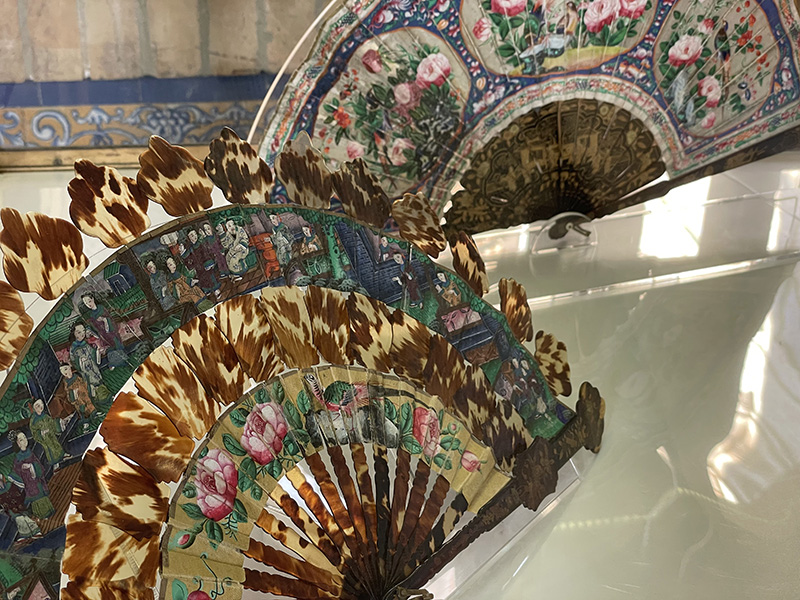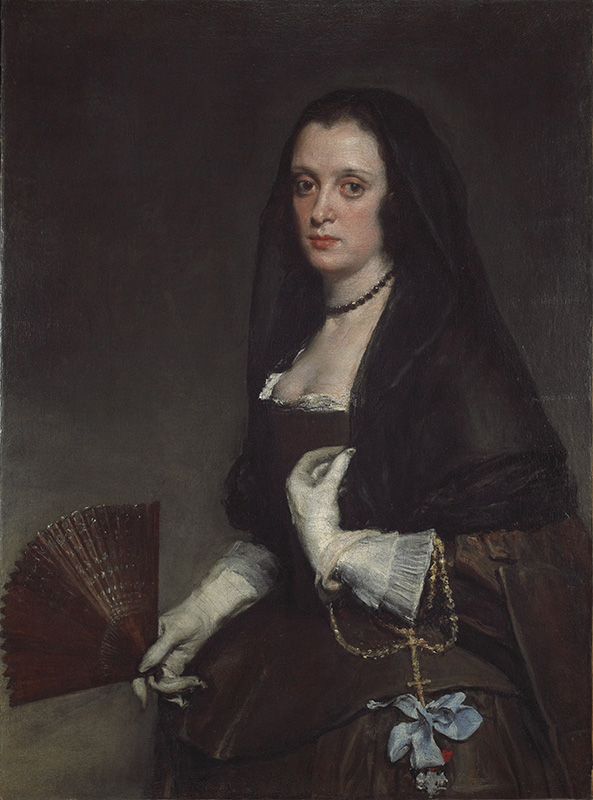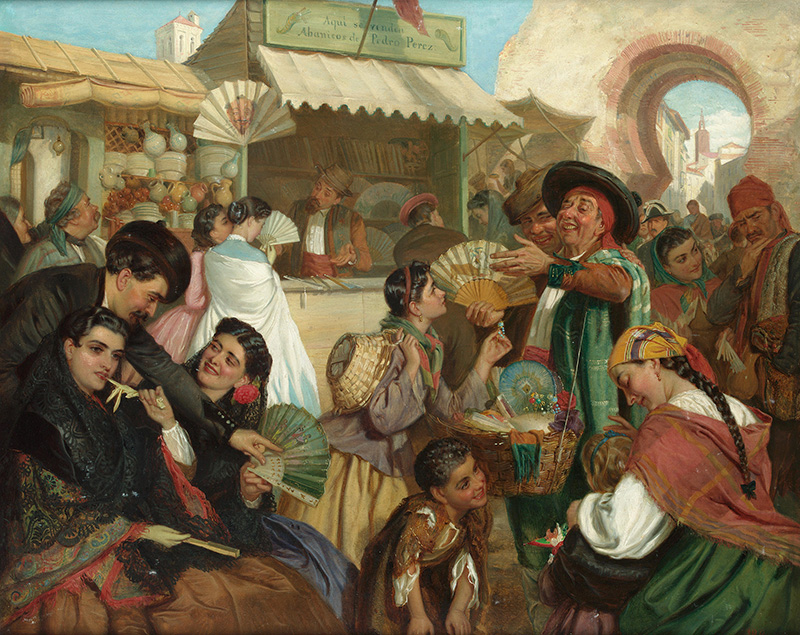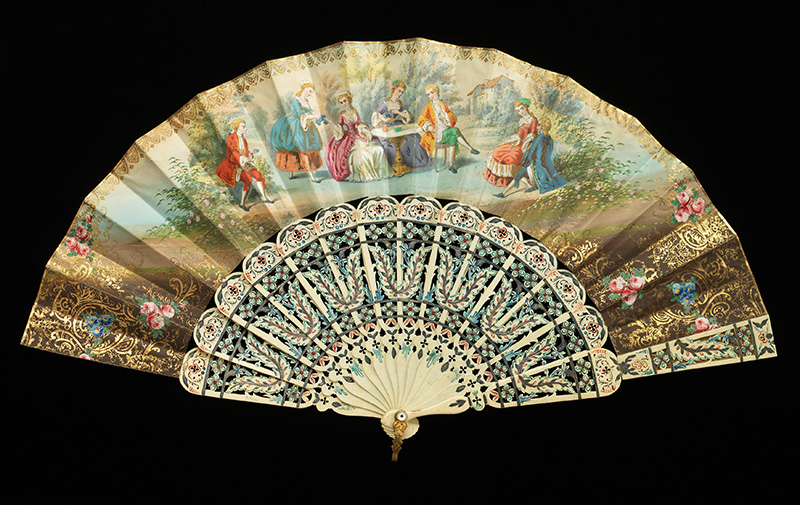The Folding Fan and Andalucía
by Carrie Greif
A flamenco dancer forcefully flicks a hand-painted folding fan. This is the quintessential vision of Spain that pops in my mind when I reflect on the Decorative Arts Trust recent Study Trip Abroad to Andalucía. We were fortunate to see these dancers in an enchanting performance in Seville, the ancestral home of flamenco. Wandering through museum and private collections, we also encountered gorgeous hand-painted fans (figure 1). The more I saw, the more inquisitive I became on the origins of the folding fan in Spanish culture.
Historians generally agree that fans, as we know them, originated in Asia, likely in China at around 2000 BCE. The fan became an important component of traditional attire for both men and women. The rigid fans would be attached to a belt. They were also found in India, where the earliest examples were made of palm leaves, and in Persia, where impressive ostrich feather fans were prominent.
Japan is credited with the invention of the “sensu” folding fan around 670 CE. The folding fan is made up of two primary parts, the stick and the mount, a mechanism likely inspired by bat wings. The stick is composed of a varying number of blades, which fold in between two guards.
The Portuguese dominated early trade with Asia, and the folding fan most likely arrived in Europe during the 15th century. By the 16th century, the fan gained popularity in courts across Europe, including Italy, France, England, and, of course, Spain. In England, fans were an adornment of female dress during Henry VIII’s reign, and Queen Elizabeth styled herself with a fan. There was extensive technical evolution of the folding fan throughout the 18th and 19th centuries, when the height and length of the fan were continuously extended.
But if the folding fan did not originate in Spain, how did it become intimately connected with Spanish culture? The folding fan is known in Spanish as an “abanico.” As they gained popularity in Europe, manufacturing increased throughout the Continent, including in Spain, where abanico craftsmanship emerged during the 17th century. Renowned painters were hired to decorate fans for the nobility. The famous 17th-century painting by Diego Velazquez, La dama del abanico (figure 2), demonstrates the emerging centrality of the fan in Spanish culture. In 1797, the Real Fábrica de Abanicos (Royal Fan Factory) was established and produced a wide variety of fans, extending their usage to all social classes, ages, and genders and to occasions ranging from parties to mourning to daily life. Other factories, such as the famous Casa de Dieg, which opened in 1823 in Madrid’s Puerta del Sol and is still in operation today, established Spain as an epicenter for folding fan production.
As Spanish manufacturers began to take hold, so did the tourism industry. After Napoleon’s attempts to capture Spain failed, the country became a popular destination first for rugged adventurists and later for more polished travelers. During this boom, Spanish culture became an export commodity. Washington Irving’s Tales of the Alhambra, published in 1832, was widely circulated and played a prominent role in introducing Spain to the world. A romanticized version of the country appeared in the popular opera Carmen, which portrayed a love triangle anchored by a Spanish Roma, or gypsy, in the title role. The opera premiered in 1875, further solidifying the centrality of many of the objects that we have come to associate with Spanish culture.
It is possible that the convergence of fan production centers and tourism throughout the 19th century solidified the fan as an icon of Spanish culture. In the 1850s, John Bagnold Burgess, a British painter and frequent traveler to Spain, depicted a fan seller, exemplifying the strong association of the fan to Spanish culture by the mid-19th century (figure 3). An example from the 1860s incorporates a complex intermingling of ivory, painted paper, mother-of-pearl, and metal and incorporates an illustration intended to draw the eye of a potential purchaser (figure 4). Fans represented the collaboration of many different specialists, whose combined skills resulted in a product worthy of a well-heeled traveler seeking a memento of their time in Spain.
Touring in Spain, we were constantly reminded about the impact of cultural exchange on decorative arts and design histories. Understanding the complexities of how objects emerge and are popularized is part of the joy of studying and experiencing them. And there is no better place to appreciate the layered identity of material culture than Andalucía.
Carrie Greif was the Curator of Educational Programs at the Decorative Arts Trust and is now the Estate Historian at Winterthur Museum, Garden & Library.
A print version of this article was published in The Magazine of the Decorative Arts Trust, one of our most popular member benefits. Join today!




